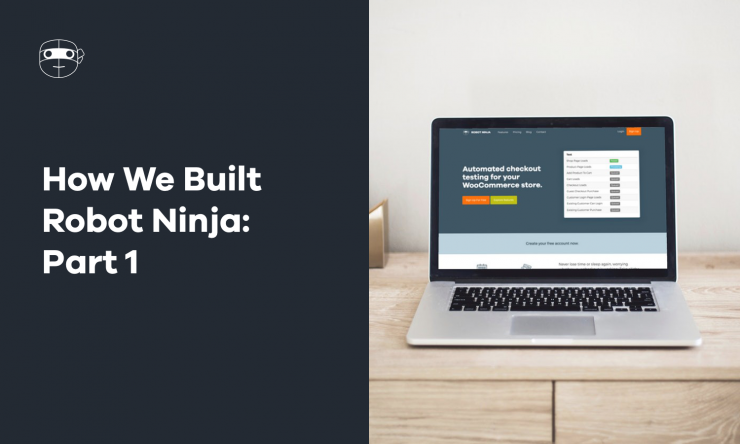Don’t let the title confuse you. This post doesn’t delve into the technical aspects of how we actually built Robot Ninja. Rather, it explores the process and methodology we used to help us come up with a new product.
Robot Ninja, if you haven’t come across it already, offers automated checkout testing for WooCommerce stores.
If there is one thing to take away from the process, it’s that from the outset we focussed on identifying problems. We didn’t go straight to working on a solution.
Building Robot Ninja: We Didn’t Reinvent the Wheel
We used concepts, processes and methodology from two best-selling books:
- Lean Product Playbook by Dan Olsen
- Blue Ocean Strategy by W. Chan Kim and Renée Mauborgne
I highly recommend checking them out.
Building a New Product: The Key Steps
Based on our understanding of the concepts presented in the above books, this is the process we followed:
- Determining our goals
- Determining our target customer
- Conducted market analysis and research
- Identified underserved customer needs
- Defined our value proposition
- Specified our MVP feature set
- Created an MVP prototype
- Tested MVP with customers
This first post in our 3-part series will cover how we worked out our goals and target customers, and then carried out market analysis and research.
Step 1: Determining Our Goals
Our aim here was to solidify our team goals to help us focus on what we wanted to achieve by creating this new product.
Taking a top-down approach, we started with our company mission and then developed lower level goals as a team that we used to guide us towards achieving the company mission. We reviewed these goals on a regular basis every 3 months.
Our CEO Brent offered insight into our company mission in a post we published on the Prospress Blog back in January – The Future of Prospress: Our 3 Year Goal.
To summarize, our mission is to help people prosper with WordPress.
We aim to achieve this by:
- Helping people sell more. Ideally, also helping them sell more with WooCommerce than they could with other eCommerce platforms.
- Helping more people sell. And helping them sell with WooCommerce, instead of any other platform.
With this high-level focus, everyone on our team is able to make decisions on their own without waiting for the OK before proceeding with a task. It gives us more autonomy to do what we need to achieve those goals within the scope of the broader Prospress team structure.
With the above in mind our initial goals for building a new product were – I must admit – very ambitious:
- Launch a product on our own within 6 months.
- Achieve 1,000 customers within 12 months (of launch)
- Support at least 1,000 customers for each team member
- Achieve an NPS score for our product of +50 within 12 months of launch, then maintain it for the following 12-24 months.
- Help our customers earn a combined total revenue of $12m over the next 36 months
We followed the S.M.A.R.T method (Specific, Measurable, Attainable, Relevant, Timely) but suffice to say, you’ll see from the amount of work outlined below that we invested much longer in the research and customer discovery phase of the project to get things right so we missed those 6 month and 12 month timeframes by a fair margin. What can I say, people are bad at estimating!
Despite the timeframe aspect, our mission, approach and goals were all still extremely useful in helping us focus and make decisions throughout the process of coming up with Robot Ninja.
Step 2: Determining Our Target Customer
The goal for us here was to identify target customers with underserved needs that we felt confident we could address.
For new products, it’s easiest to start with a judgment or hypothesis, and then talk to prospective customers and review/iterate as frequently as possible.
So that’s what we did.
We came up with 4 problems we believed a lot of people in the WordPress and WooCommerce space were experiencing that we thought would be worth exploring. Some of these ideas were new while others we’d identified as being around for quite some time. These were our problem spaces.
Based on our hypothetical problem spaces, we then came up with a number of hypothetical profiles/personas with background stories, jobs, demographics etc. and used these to help target people for interviews, research and surveys.
Between our team members, we have over a decade of experience in the WordPress and WooCommerce space, so coming up with realistic characters was fairly easy (and a little bit fun 😉).
In total, we came up with 24 personas to validate and iterate on as our research unfolded. Here are some of the original personas we came up with (see if you can spot the easter egg)…
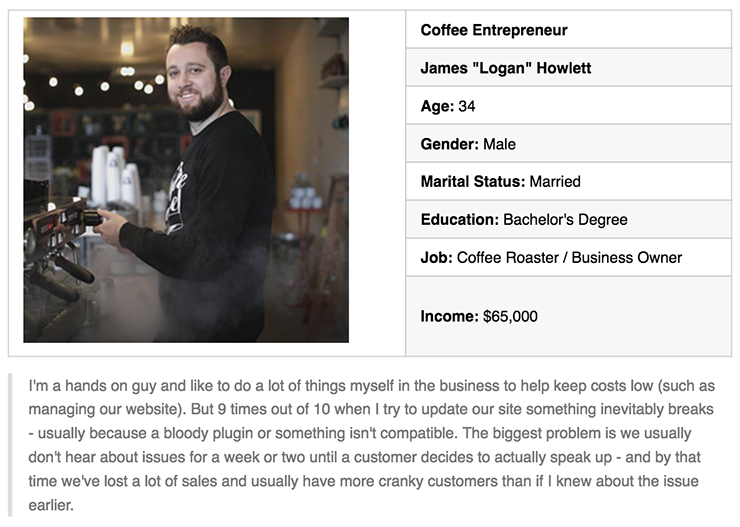
There was definitely a bit of an uncanny valley vibe going on!
These hypothetical problems and personas then formed the basis for conducting broader market research as well as helping us to target individuals for customer interviews as part of identifying underserved customer needs (which we’ll discuss in a later post).
Step 3: Conduct Market Analysis and Research
The goal for us during this stage of the process was to assess the “attractiveness” of the market into which our problems fit, the idea being that through conducting broader research and analysis, we could more clearly define and articulate our intended market.
We also took the time to asses our fit for each of the problems and the markets. For example, are we (Prospress) a good fit for them? And are we in a good position to make a difference? These were just some of the questions we asked ourselves.
There were a number of tools, techniques, and strategies that we used during this step. There are many more out there we could’ve employed. It’s important to note that what worked for us might not work for you and will also depend on your resources and how much time you have.
SWOT Analysis
SWOT analysis is a useful technique for understanding your strengths and weaknesses, and for identifying both the opportunities open to you and the threats you face. Strengths and weaknesses are often internal to your organization, while opportunities and threats generally relate to external factors.
We used SWOT analysis to help us identify which problems would be a good fit for us for us to solve. It also helped us to identify some of our weaknesses, enabling us to address them if/when needed.

The Six Thinking Hats
The Six Thinking Hats is a tool for brainstorming and innovation articulated by Edward de Bono. The technique breaks down thoughts into six “parallel” or “lateral” areas to be separately discussed, and aimed at allowing a spectrum of thought, from gut feeling to data analysis.

By using these six types of thinking in a structured way (the hats), you can more effectively approach problem solving.
We found the technique very complementary to other analysis techniques such as SWOT Analysis.
It helped us think more creatively about the problems we had formulated and often from perspectives we wouldn’t normally consider or be comfortable with (in the case of the black hat when approaching the problem as the devil’s advocate).
Google Trends
Google Trends is a free tool provided by Google that shows (in real-time) how often a particular search-term is entered relative to the total search-volume across various regions of the world, and in various languages.
We used Google Trends to help give us a very rough indication of the level of popularity for end-to-end testing (as well as range of other search terms) and it provided a unique perspective on what people were interested in and curious about.
Most importantly, it allowed us to compare search terms and also see regions around the world where certain terms are most popular.
For example, you can see the trends for search terms like “woocommerce”, “selenium” and “e2e testing” over the past 5 years. And you can see where in the world those terms are most popular.


An interesting trend to keep an eye on is the comparison between the popularity of Shopify as a search term vs WooCommerce:

It is important to note that Google Trends can be bit of a blunt instrument at times so it’s important to use it in combination with other sources of data.
Facebook Group Trends
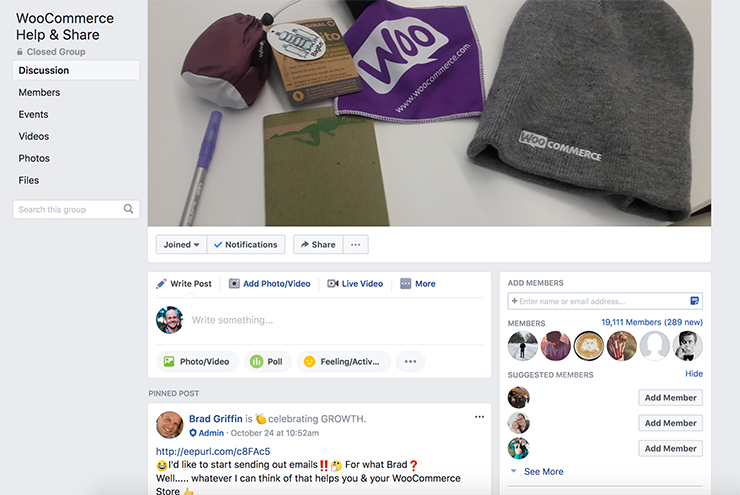
The Advanced WooCommerce and WooCommerce Help & Share Facebook groups are both very active groups in the WooCommerce space. Each group receives many posts per day (and responses to said posts) from its members seeking feedback and/or help with problems/difficulties they come across.
The Advanced WooCommerce group has 17,958 members and is headed up by a number of the WooCommerce Ninjas and team members.
The WooCommerce Help & Share group has 19,010 members and is headed by Brad Griffin.
We decided it would be useful and interesting to take a “rough snapshot” of what some of the recurring themes were within the two groups.
I say “rough snapshot” as we tagged posts according to topics and themes based purely on what we thought the posts related to, so it was very subjective.
The below themes are the result of looking at the 100 most recently updated posts as of 8pm on 24 October 2016:
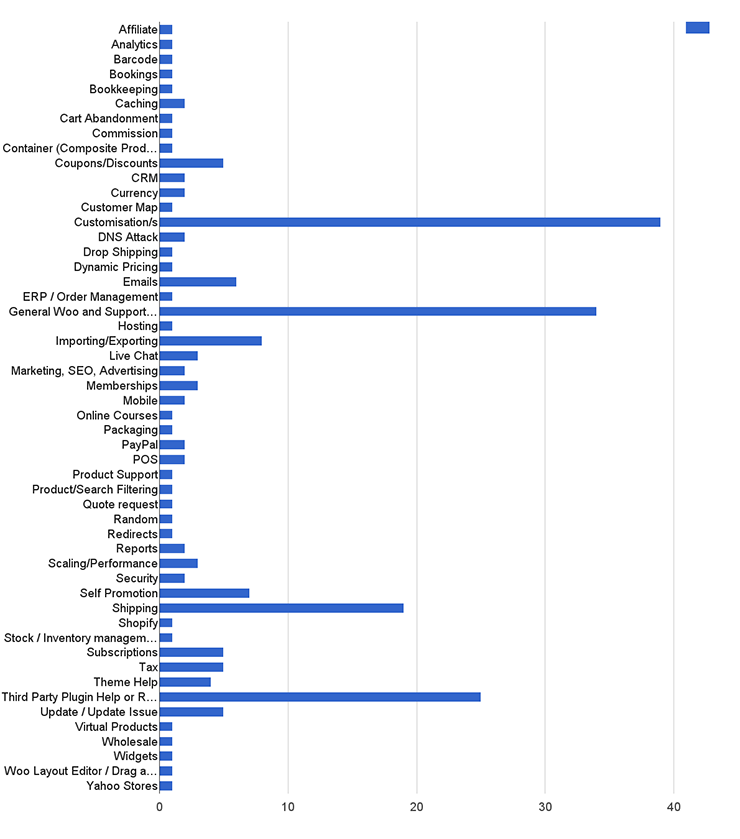
The most common posts related to:
- Customizations
- General Woo questions and support, i.e. how do I enable x or disable y
- Third party plugin recommendations
- Importing and exporting
- Self Promotion and spam
- Coupons and discounts
- Subscriptions
- Update Issues
Market Analysis
We also used more mainstream sources of data and statistics, such as data from the Australian Bureau of Statistics (ABS) and research conducted by educational and industry bodies.
Did you know…. that people in the 55-64 age group have started new businesses at a higher rate than those in their twenties and thirties in every single year from 1996 to 2013?
That’s one statistic we found very interesting whilst investigating our hypothetical problem spaces.
We also used stats from services like Builtwith to help us make decisions. BuiltWith is where the popular WooCommerce usage stat comes from that states that WooCommerce powers over 28% of all online stores.
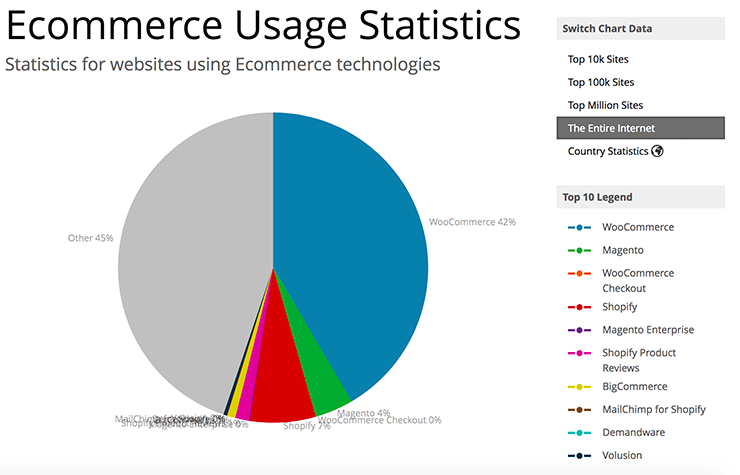
Market Survey
Late last year we ran The Great WooCommerce Community Survey (TGWCS) in conjunction with our friends at WooCommerce and other prominent WooCommerce businesses to paint a picture of the global WooCommerce community.
I won’t say much about the survey in this post as we’ll be publishing more about this soon on the Prospress Blog, but it’s been a hectic year for me personally and I haven’t yet been able to publish the results and find the time to do them justice (but we will be).
Suffice to say, there was some interesting demographic and usage data to come from it such as:
- 77% of respondents answered “yes” to “Do you test your checkout with test purchases from time to time to make sure it is working correctly?”.
- 83% of respondents answered “no” to “Have you ever looked for a hosted WooCommerce solution?”
If you can get relevant data like this it is extremely valuable for your decision-making process. It certainly was for us, and for this reason we want to make it available for the entire community so that everyone can benefit from it. Watch this space.
Wrapping Up
So that concludes our first post in this series about how we built Robot Ninja. Hopefully, it has provided you some insight into how we got started with working out our goals, target customers and some of the tools we used to conduct our market analysis and research.
In part 2 next week, I’ll cover how we identified underserved customer needs using customer discovery interviews and the techniques we used to help define our value proposition.
